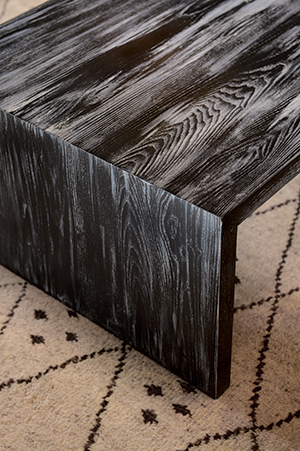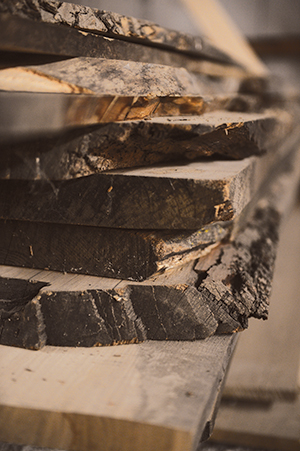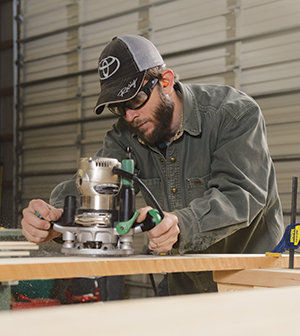Writer: Vicki Ingham
Photographer: Duane Tinkey
Some of the ash trees doomed by the onslaught of the emerald ash borer may find a better (if no less deadly) fate than a grisly wood chipper.
Master craftsman Clay Aronson appreciates the character of salvaged wood and hopes to offer the ash lumber a more artistic destiny through the custom furniture he builds. His thesis project for an architecture degree at Iowa State University used reclaimed barn wood from local farms. So when he and his wife, Megan, learned that the city of Des Moines would be removing threatened ash trees, they wondered if they could salvage some of them.
The city, which has about 13,000 ash trees around buildings and along roadsides and trails, can’t afford to save all of them. Municipal arborist David Jahn says 2,400 trees are currently being treated and another 5,600 will be removed over the next 10 years. The remaining 6,000 are in parks and will be left in place to die on their own. (Even dead trees have a place in the ecosystem of a forest, however, so they’re not a total loss.)
To get access to the trees being removed, Megan made some phone calls that led her to Jahn. He referred her to Family Tree Service, the firm designated to take down the targeted ashes. “He was wonderful,” Megan says of Jahn. In fact, she adds, “when people hear what we’re about and what we want to do, they’re really supportive.”
Last fall, Clay Aronson started picking up some of the felled trees. Starting this spring, he’ll mill the logs using equipment that was built for the old Buttermore Mill west of Boone. The boards must air-dry for about a year before he can begin working with them. (He hopes to build a kiln to speed up the drying process, but that’s still on the drawing board.)
After graduating from ISU, Aronson apprenticed for two years with Robby Pederson at RVP-1875, a 19th-century woodworking shop in Story City. There he learned traditional woodworking techniques using hand tools. “You learn more about the wood that way,” he says, “how the grain runs, how wood acts.”
Although he relies on power tools now, he still adheres to traditional joinery techniques, using mortise-and-tenon joints and butterfly splines to hold pieces together. “I try to stay as true to the older methods as I can,” he says. “They’ve been time-tested.”
The joinery may be traditional, but his newest finishes have a dramatic, contemporary look. Named Spanish Dove for two of the colorants used, they require a time-consuming multistep process that is as much the result of creative experimentation as of technical skill. Each piece is protected with a cabinet-grade varnish that creates a hard, durable surface that’s resistant to water and chemicals.
Aronson installed the first floating vanities with the Spanish Dove finish in the spring of 2015 for Jenny Weber, one of the founders of the Des Moines Triathlon Club. The collaboration led to the opportunity to develop a new line of vanities available exclusively through Minnesota Cabinets in Clive. (To express their appreciation to Weber and to honor her work with the club, the Aronsons are donating a portion of the proceeds from sales of the vanities to help disadvantaged youths participate.) Minnesota Cabinets also features Aronson’s one-of-a-kind tables in its showroom.
Aronson’s tables also are available at Renovation Home in downtown Des Moines, and R. Cartwright Design is planning to offer his furniture at the company’s new studio space, which at press time was scheduled to open in January in Clive.
Aronson has already cut down some ash trees for a homeowner in exchange for the lumber. Locally harvested trees have “more burly grain, more colors, more character than the ash you buy from a lumber company,” he says, “because they’re looking for consistency.”
Megan Aronson handles the marketing end of the business and may be her husband’s biggest fan. “It’s truly an art, how he applies the finishes,” she says. “He’s very particular about how he does it. It’s fascinating to watch.”
As a TreeKeeper with Trees Forever, freelance writer Vicki Ingham is acutely aware of how the emerald ash borer will change the city’s streetscapes. The idea that Clay Aronson can salvage even a fraction of the ashes is somewhat comforting. “The thing that surprised me about his furniture,” she says, “is how he uses traditional joinery techniques to create very contemporary-looking pieces.”









